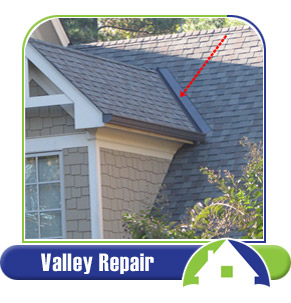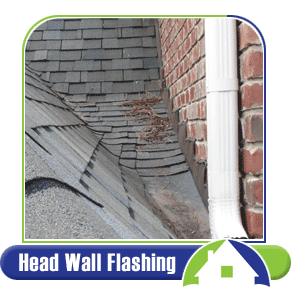All repair work is guaranteed and includes a written leak-free warranty.
A roof leak is a major nuisance for most homeowners. Finding a leak can be frustrating. The vast majority of roof coverings operate using the principal of gravity. This can be a big help in locating a leak source. However, horizontal roof boards can trick you. A leak may actually be eight to 10 feet sideways from where you see the wet ceiling or spot in the attic.
 |
The Field of Shingles
If your roof is older, it is possible that the leak is within the roof field. This means the expanse of shingles. A thorough inspection will determine whether or not your leak is within the field of shingles. Do not attempt to climb your roof. There are millions of sand-like granules that cover the roof. Under foot pressure, these granules can become dislodged, especially if the roof is older, and could have an avalanche effect, causing you to lose your footing, risking serious injury.

|
| |
|
Valleys
A valley is a line where two roof planes intersect. Valleys are installed in different ways. Some valleys have metal flashings, others are under lapped and upper shingle cut to form a straight line in the center of the valley. The most common valley installed in North Carolina is the weaved or laced valley. Valleys can be big problems if the shingles are not trimmed correctly. When you trim a shingle for a valley you end up with a chisel point on the end of the shingle. If a second cut is not made to make this point like an arrow point, then water can travel along the top of the shingle and find its way inside your house.
 |

|
| |
|
 |
Head Wall Flashings
Some roofs stop at a vertical wall. A metal or membrane flashing must be in place to direct water streaming down the wall away from the stopping point of the shingles. This flashing may be behind wood siding or in front of a brick wall. The flashing should extend over the shingle. If the wall is brick or other masonry, the flashing must bend and extend one inch into a mortar joint. Roofing cement should never be used in conjunction with these materials. If you see this, it is a sign that someone tried to improperly repair the leak.
 |
| |
|
Wall Step Flashing
Some roof leaks happen at step flashings. You find these flashings where a roof climbs alongside a vertical wall. As each row of shingles is laid, a step flashing is installed over the shingle next to the wall. Part of the step flashing turns up onto the wall and the other portion gets covered by the next row of shingles. If flashing is installed along brick or an exposed veneer wall, then a counter-flashing must be installed in order for the flashings to function properly.
 |

|
| |
|
 |
Chimneys
Chimneys are a common source of leaks. Chimneys contain four different types of flashing and are one of the most complex areas on the roof. Chimneys must be regularly inspected and properly maintained to ensure a leak free dwelling.
 |
| |
|
Plumbing Vent Flashing
Many of these incorporate a rubber seal with a urethane flashing. The rubber collar can meet its life expectancy in as little as 5 to 7 years depending on sun exposure and attic temperatures. The boot flashing should be installed under the shingles that extend up the roof from the middle of the plumbing vent. The bottom half of the boot flashing should be exposed and actually cover the granulated top side of the shingles.
 |

|
| |
|
 |
Furnace or B-Vent Flashing
These flashings are basically identical to plumbing vent flashings. However, they sometimes have a metal storm collar. These fit tightly around the vertical pipe that exits the roof. If they become loose, the storm collars can cause leaks.
 |
| |
|
Ice Dam Leaks
These leaks can happen even if everything on your roof is just fine! Ice dams block the natural flow of water down a roof. The water begins to back up under flashings, shingles, tar paper, etc. Once water begins to flow into the house, it can drip for days. The only means of prevention is to install membranes under the roofing. The membranes will stop water leaks if installed properly.
 |

|
| |
|
 |
Wind Blown Rain Leaks
Wind driven rain can also be a major problem. Wind will drive water up and under your roofing materials. One line of defense, if properly installed, is water and ice dam membranes.
Roofing cement should be applied under shingles on the edges of roofs that face the wind. Don't underestimate the power of a 50 mph sustained wind-driven rain.
 |
| |
|
 |
 |
 Got a leak? Olde Raleigh Roofing will quickly fix your roof leaks - Guaranteed!
Got a leak? Olde Raleigh Roofing will quickly fix your roof leaks - Guaranteed! Our courteous roofing professionals will thoroughly inspect your roof and offer expert maintenance and repair services to keep it in excellent condition. A leaking roof doesn't necessarily mean it's time for replacement. Repairing a roof can save you thousands of dollars in lieu of replacement.
Our courteous roofing professionals will thoroughly inspect your roof and offer expert maintenance and repair services to keep it in excellent condition. A leaking roof doesn't necessarily mean it's time for replacement. Repairing a roof can save you thousands of dollars in lieu of replacement.


